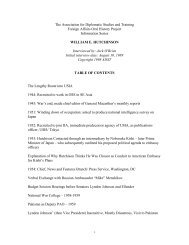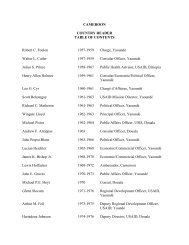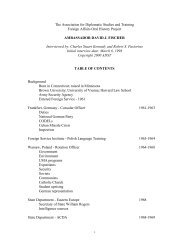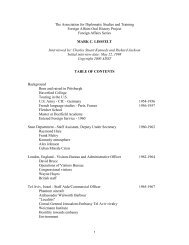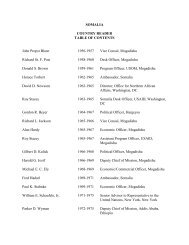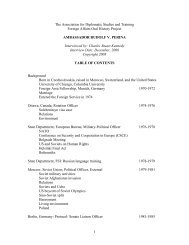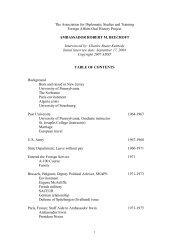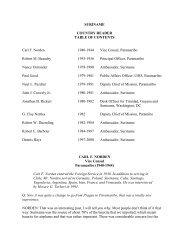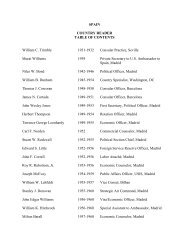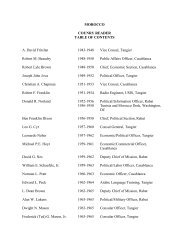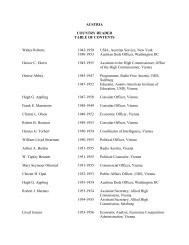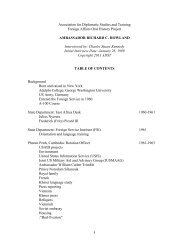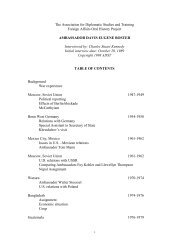1 The Association for Diplomatic Studies and Training Foreign ...
1 The Association for Diplomatic Studies and Training Foreign ...
1 The Association for Diplomatic Studies and Training Foreign ...
You also want an ePaper? Increase the reach of your titles
YUMPU automatically turns print PDFs into web optimized ePapers that Google loves.
MILLER: <strong>The</strong> building was only – the consulate was only one block away, <strong>and</strong> it faced<br />
the Mojasemeh, <strong>and</strong> bordered on the north by a small stream which was dry part of the<br />
year, but was part of the irrigation system, they are called mahdis in Isfahan <strong>and</strong> the<br />
mahdis are part of some comic events later. This was a feature of Isfahan, that it had<br />
canals, so to speak, <strong>for</strong> irrigation. From the Zay<strong>and</strong>eh Rud River, the main stream that<br />
comes down from the Zagros Mountains. <strong>The</strong> word Zay<strong>and</strong>ehrud means “the living<br />
river,” which it literally is, it gives life to that whole part of Iran.<br />
So the consulate was on one side <strong>and</strong> the bicycle shop was under us <strong>and</strong> next to us on the<br />
other was the home of an Armenian, doctor/antiquarian named Doctor Caro Minassian,<br />
who was one of the few good physicians of Isfahan. He was a leader of the Armenian<br />
community, <strong>and</strong> an extremely learned man. We became very good friends. He introduced<br />
us to the world of archaeology, antiquities <strong>and</strong> learning in Isfahan. He cared <strong>for</strong> us<br />
medically on occasion when we were in need of help. He <strong>and</strong> his wife were very, very<br />
good friends. He gave us an introduction to the art <strong>and</strong> literature <strong>and</strong> history of Isfahan<br />
from the 16 th century to the present day. He himself was living example of a descendent<br />
of those Armenians who came in the time of Shah Abbas <strong>and</strong> prospered in this Persian<br />
l<strong>and</strong>scape.<br />
He also kept various animals in his garden next to ours, including, as I recall, two<br />
enormous l<strong>and</strong> tortoises. <strong>The</strong>y were the size of coffee tables. <strong>The</strong>y were enormous. <strong>The</strong>y<br />
were delight <strong>for</strong> children who would ride them. He had desert birds <strong>and</strong> so on. He was a<br />
wonderful, wonderful man – a kind of Dr. Doolittle.<br />
<strong>The</strong> consulate itself was made out of a 19 th century building that had been a merchants<br />
residence. It was basically an entry hall with one or two offices on the ground floor <strong>for</strong> the<br />
Iranian staff of which we had three, not including the guards. <strong>The</strong> senior Persian assistant<br />
was Baquer Dehesh, a courtly, very h<strong>and</strong>some well educated well respected citizen of<br />
Isfahan. Mr. Dehesh, whose polite manners exemplified the best of Iranian culture was<br />
educated in Tehran at Alborz College under the legendary Dr. Jordan. Alborz College, a<br />
Presbyterian missionary college which educated many of Iran’s leaders during the 20s,<br />
30s, 40s, <strong>and</strong> fifties. Mr. Dehesh was well known to all the key officials, bazaari, clerics<br />
<strong>and</strong> tribal leaders of Isfahan <strong>and</strong> it was through Mr. Dehesh that I met all the key leaders<br />
of Isfahan <strong>and</strong> was able to learn about many of the particular ways of Isfahan. He <strong>and</strong> his<br />
wife made our entry into Isfahani life an easy transition. <strong>The</strong>re was also Khalil Ghazagh,<br />
who a was jack-of-all-trades administrative assistant – he translated, he was the<br />
receptionist, he typed unclassified material. He was an access to places <strong>and</strong> people that<br />
we needed. <strong>The</strong>n there was a man named Sayed Soroosh, who was a university professor,<br />
but was the assistant to the USIA, USIS person. He, of course, knew the university<br />
people, <strong>and</strong> many of the learned of Isfahan.<br />
<strong>The</strong>n there was a third Persian named Abol Hassan Sepenta, a brilliant poet <strong>and</strong><br />
filmmaker who worked <strong>for</strong> the Americans because he needed money. He was also a<br />
newspaper man, he was the editor of a one man Isfahan newspaper Spenta. He became a<br />
very good friend right to the end, right to his death. He really knew the country <strong>and</strong> loved<br />
28




